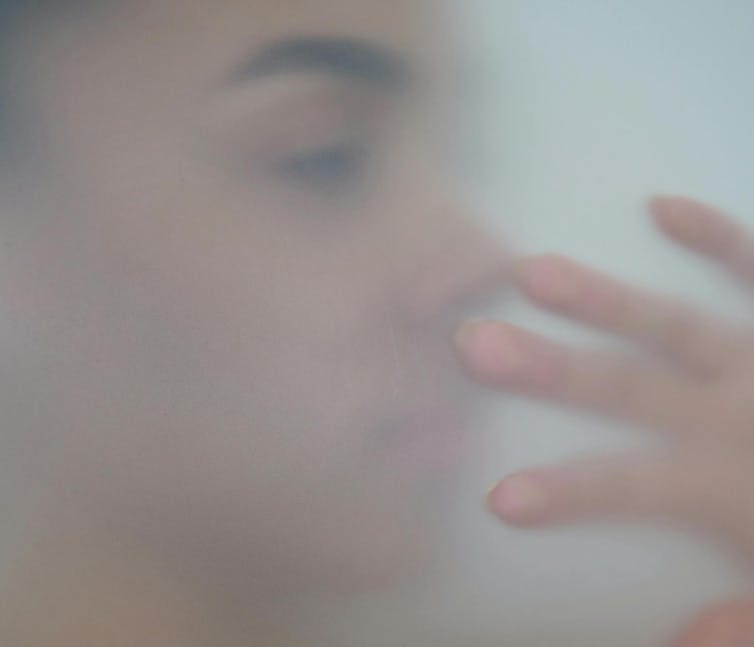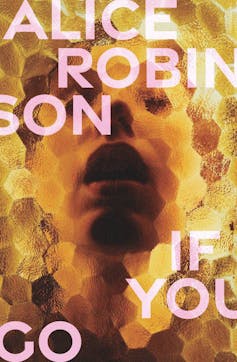Alice Robinson’s third novel (and second foray into speculative fiction) begins with a mother’s bittersweet “second chance at life” – one she never asked for.
One hundred years in the future, 40-year-old Esther is the first of 47 sleepers to be “woken” from cryogenic suspended animation in an underground bunker. She does not know where her children are, and is being cared for by a strange woman her mother’s age, Grace. Over the course of the novel, Esther anxiously speculates on the length of her sleep and reckons with her new reality, as she slowly begins to remember her life and her children.
If You Go unites various tropes and themes of domestic and speculative fiction. Its reflections on loneliness and the personal sacrifices of motherhood are set in a future where the environmental, social, political and economic crises of today are exacerbated.
Review: If You Go – Alice Robinson (Affirm Press)
Esther is confronted but unsurprised by the “climactic instability” of the future she awakes in, as well as the proliferation of war and the widening gap between the rich and poor, which has intensified in the world she once knew. Yet what is truly disturbing is her sober realisation: “I had failed to prepare my children for their future.”
Drawing on thriller techniques, Robinson creates tension by slowly revealing why Esther’s life was “suspended” – and who Grace really is. Reawakened in a world that continued to exist without her, Esther must grapple with the incoherence of a body and life put into stasis.

If You Go is more intimate, more insular, and much darker than Robinson’s previous works, Anchor Point (2015) and The Glad Shout (2019), which were concerned with land management, family responsibilities, and fraught mother–daughter relationships.
By contrast, If You Go is more interested in personal expectations of motherhood and templates for it, and the loneliness of single parenthood. The novel is told from the first-person perspective of Esther, single mother to two children and the child of a broken family herself.
In her life before the suspension, Esther was plagued by a sense of her failure as a parent and her struggle to work, write and survive the everyday difficulties we all know well, including the merciless cost of living.
Robinson deftly conveys Esther’s desperation as she calls in favours, conceals lowbrow freelance writing jobs from her family, and attempts teaching work she’s unpractised at. All work that “wasn’t enough” and left Esther watching her “savings tick down like the timer on a bomb”.
Australian motherhood, in writing
The narrative is dominated by Esther’s memories, rather than her hopes for the future. Accordingly, it is organised as a sequence of vignettes that highlight crucial scenes from Esther’s childhood, early motherhood, marriage and life after separation from her husband, Jean-Paul.
Each vignette illuminates moments of neglect, emotional detachment and claustrophobia. For example, Esther remembers a photograph her father, Charles, took of her at 15 as she first read Vivienne’s published work. She had hoped Charles would “explain the books to me – explain my mother”. Instead, he just naively staged the shot.
Robinson captures Esther’s melancholy in Charles’s eager attempt to capture the impermeable and transient. Ironically, for Esther, the subsequently celebrated photograph only cemented her own sense of disconnection. With isolation providing the space for constant reflection, the loneliness Esther feels in the bunker is amplified by the loneliness that informed each relationship in her life.

Here, Robinson participates in an expanding trend of Australian female authors writing about motherhood in fiction and autofiction. There’s Helen Garner, Ceridwen Dovey, Meg Mason, Lucy Treloar, Briohny Doyle and Kate Mildenhall. They all delve into the restrictions imposed by motherhood, the gendered imbalance of caring duties in parenthood and the deceptive narratives surrounding familial bliss.
Robinson continues this tradition by engaging with conflicting narratives of romanticised motherhood and authentically messy motherhood, validating the mothers who stay by examining the circumstances that prompt their desires to abandon the mess. She particularly excels at portraying motherhood’s darker aspects. If You Go responds to pressing social questions of how to do it all: how to be mother, worker, wife and person, and how to be independent in circumstances of intense dependence.
Throughout the novel, Esther remembers small moments of happiness with her children, but these are repetitively and frustratingly quashed by memories of her own mother’s “disdain for maternal nostalgia.” In a conversation begun by Esther about “how quickly the children were growing, sounding too earnest and forlorn for my mother’s tastes,” we see her mother Vivienne’s assessment:
“Goodness do you think that women are only of value when they’re mothering?”
“It just goes by so fast, I guess …”
“You think your work will be done when they’re grown up? […] I’ll never understand why women are so hellbent on cherishing every moment with babies. Once you have a child, they’re with you for life. It’s not as if they grow up and stop needing their mothers.”
Again and again, Esther evaluates her own performance of motherhood against the “template” of her mother’s example. Her parents’ divorce, her mother’s long-distance contact with Esther, and Vivienne’s prioritisation of her academic work on “women’s entitlement to freedom from marriage and motherhood” left Esther yearning for maternal affection.
Charles, Esther’s father, explains to her, “Your mother’s politics made it very difficult for her to love me.” The same seems to be the case for Esther. Rather than the fondness she craves, Esther receives the affirmation that she deserves to “take up space on the planet.”
Through Esther, Robinson references Nobel Prize-winning French autofiction writer Annie Ernaux’s notion of “the void” as an articulation of this experience. The internal void, Ernaux suggests, is filled through an “inexhaustible” cataloguing of “reality.” She cites memories, objects, trivial facts and dream narratives.
Robinson employs Ernaux’s notion of “the void” as a guiding force that structures the novel: “this litany of ‘I remembers’” functions as a sense-making exercise for Esther, an arrangement of the self and of time – particularly in her context of disorientation.
Emotional lockdown in a speculative future
If You Go mirrors significant aspects of Robinson’s own life: she is a Melburnian mother of two with a PhD in creative writing, daughter of a visual artist, who has written about her experience of marriage and separation.
The novel clearly demonstrates a degree of self-reflexivity, drawing on Robinson’s experience of managing writing and single parenting during the COVID-19 lockdowns, without explicitly addressing the pandemic.
Instead, Robinson illustrates the concept of emotional lockdown in a speculative future that is similarly unprecedented. Robinson’s close emotional observations on grief, yearning, disappointment, sorrow and loneliness don’t refute her book’s categorisation as autofiction, but create an authentic and complex protagonist in Esther.
Loneliness dominates Esther’s experience. As presented in the novel, motherhood, especially single motherhood, is gruelling and unforgiving. But it seems as if Esther’s personal development is stunted. Perhaps this is inevitable: her life was cut short at 40.
The novel spends much time recounting the details of Esther’s dogged preparations for her children’s futures, but her character outside of this frame can at times feel thin. The most satisfying moments arise when Esther’s self-reflections take centre stage. She reflects on the feelings of powerlessness to protect her children from the disruption of a broken family, and her misguided expectations about motherhood:
I had gone into motherhood hoping to be elevated in some way by the experience. But what having Clare and Wolfie did instead was expose […] the many wounds and flaws in my character that I otherwise hadn’t appreciated were there.
Esther’s struggles with the templates of womanhood are inherited from her mother and the women around her. Her own struggles with motherhood – particularly the resentment of (and obsession with) the burden of caregiving – resonate with countless literary voices in this space.
Depression dominates Esther’s “before” life. But her “after” life indirectly suggests the possibility of a hopeful future where, like it or not, she is without her children. If Esther’s agency has been so restricted by motherhood, freedom comes through no longer being a caretaker.
Challenging the child as future hope
In this, the novel challenges the trope of the child as the harbinger of – and hope for – the future. By injecting complexity into conversations around motherhood and caregiving, Robinson raises unsettling ethical questions that the novel is not entirely capable of answering.
Is it morally justified to make life-and-death decisions for individuals who cannot consent to those decisions? What responsibilities do we have for preserving life and facilitating its continuation? How should we balance individual autonomy with collective welfare when dealing with advanced medical interventions?
The strength of this novel is Robinson’s intimate portrayal of the fracturing of relationships, as well as the poignant exploration of frustrated ambitions and unappreciated effort. She also vividly renders emotion: the cold numbness of grief, the colourful heat of rage, the nauseating vertigo of shock, the violent pang of yearning, the drawn-out ache of loss.
It seems the novel lacks a sense of optimism beyond Esther’s dismal reflections: perhaps a deliberate choice by Robinson, to emphasise the often futile promises of happiness. Moments of reprieve appear sparingly, when Esther forgets her insecurities, irritation and worries.
On the final page, we return to Esther’s life before the separation: “I think that we’ll be happy here,” Jean-Paul says. The promise of a “new chapter” in their new house is warm and inviting. But it’s a sentiment we know will be short-lived.
Caitlin Macdonald receives funding from the Australian Government Research Training Program scholarship.
This article was originally published on The Conversation. Read the original article.







